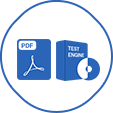Last Update 5 hours ago Total Questions : 95
The NVIDIA Generative AI LLMs content is now fully updated, with all current exam questions added 5 hours ago. Deciding to include NCA-GENL practice exam questions in your study plan goes far beyond basic test preparation.
You'll find that our NCA-GENL exam questions frequently feature detailed scenarios and practical problem-solving exercises that directly mirror industry challenges. Engaging with these NCA-GENL sample sets allows you to effectively manage your time and pace yourself, giving you the ability to finish any NVIDIA Generative AI LLMs practice test comfortably within the allotted time.
In the field of AI experimentation, what is the GLUE benchmark used to evaluate performance of?
Which of the following is a parameter-efficient fine-tuning approach that one can use to fine-tune LLMs in a memory-efficient fashion?
What is the fundamental role of LangChain in an LLM workflow?
Which of the following best describes Word2vec?
What do we usually refer to as generative AI?
You are in need of customizing your LLM via prompt engineering, prompt learning, or parameter-efficient fine-tuning. Which framework helps you with all of these?
You have developed a deep learning model for a recommendation system. You want to evaluate the performance of the model using A/B testing. What is the rationale for using A/B testing with deep learning model performance?

